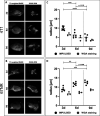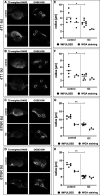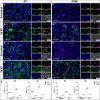Profiling specific cell populations within the inflammatory tumor microenvironment by oscillating-gradient diffusion-weighted MRI
- PMID: 36918222
- PMCID: PMC10016257
- DOI: 10.1136/jitc-2022-006092
Profiling specific cell populations within the inflammatory tumor microenvironment by oscillating-gradient diffusion-weighted MRI
Abstract
Background: The inflammatory tumor microenvironment (TME) is formed by various immune cells, being closely associated with tumorigenesis. Especially, the interaction between tumor-infiltrating T-cells and macrophages has a crucial impact on tumor progression and metastatic spread. The purpose of this study was to investigate whether oscillating-gradient diffusion-weighted MRI (OGSE-DWI) enables a cell size-based discrimination between different cell populations of the TME.
Methods: Sine-shaped OGSE-DWI was combined with the Imaging Microstructural Parameters Using Limited Spectrally Edited Diffusion (IMPULSED) approach to measure microscale diffusion distances, here relating to cell sizes. The accuracy of IMPULSED-derived cell radii was evaluated using in vitro spheroid models, consisting of either pure cancer cells, macrophages, or T-cells. Subsequently, in vivo experiments aimed to assess changes within the TME and its specific immune cell composition in syngeneic murine breast cancer models with divergent degrees of malignancy (4T1, 67NR) during tumor progression, clodronate liposome-mediated depletion of macrophages, and immune checkpoint inhibitor (ICI) treatment. Ex vivo analysis of IMPULSED-derived cell radii was conducted by immunohistochemical wheat germ agglutinin staining of cell membranes, while intratumoral immune cell composition was analyzed by CD3 and F4/80 co-staining.
Results: OGSE-DWI detected mean cell radii of 8.8±1.3 µm for 4T1, 8.2±1.4 µm for 67NR, 13.0±1.7 for macrophage, and 3.8±1.8 µm for T-cell spheroids. While T-cell infiltration during progression of 4T1 tumors was observed by decreasing mean cell radii from 9.7±1.0 to 5.0±1.5 µm, increasing amount of intratumoral macrophages during progression of 67NR tumors resulted in increasing mean cell radii from 8.9±1.2 to 12.5±1.1 µm. After macrophage depletion, mean cell radii decreased from 6.3±1.7 to 4.4±0.5 µm. T-cell infiltration after ICI treatment was captured by decreasing mean cell radii in both tumor models, with more pronounced effects in the 67NR tumor model.
Conclusions: OGSE-DWI provides a versatile tool for non-invasive profiling of the inflammatory TME by assessing the dominating cell type T-cells or macrophages.
Keywords: T-lymphocytes; immunotherapy; macrophages; translational medical research; tumor microenvironment.
© Author(s) (or their employer(s)) 2023. Re-use permitted under CC BY-NC. No commercial re-use. See rights and permissions. Published by BMJ.
Conflict of interest statement
Competing interests: None declared.
Figures







References
Publication types
MeSH terms
LinkOut - more resources
Full Text Sources
Medical
